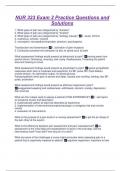NUR 323 Exam 2 Practice Questions and
Solutions
1. What types of pain are categorized by "duration"
2. What types of pain are categorized by "location"
3. What types of pain are categorized by "etiology (cause)" ✅1. acute, chronic
2. cutaneous, somatic, visceral
3. nociceptive, neuropathic(intractable, phantom, psychogenic)
Transduction and transmission ✅1. activation of pain receptors
2. Conduction process from sensation at site, to spinal cord, to brain
What assessment findings would present as behavioral to pain? ✅moving away from
painful stimuli. Grimacing, moaning, and crying. Restlessness. Protecting the painful
area and refusing to move.
What assessment findings would present as physiologic to pain? ✅typical sympathetic
responses when pain is moderate and superficial. Inc BP, pulse RR. Pupil dilation,
muscle tension, inc adrenaline output, inc blood glucose,
Parasympathetic when pain is severe and deep: nausea and vomiting, fainting, dec BP,
pulse, prostration
What assessment findings would present as affective responses to pain?
✅exaggerated weeping and restlessness, withdrawal, stoicism, anxiety, depression,
fear anorexia
What are the 4 steps used to assess a patient's PAIN EXPERIENCE? ✅1. self-report
for presence of pain and description
2. systematically gather all data that describes pt experience
3. implementation of interventions(nonpharmacologic or analgesic trial and monitor
results.
4. evaluation of interventions
What is the purpose of a pain scale in a nursing assessment? ✅to get the pt ratings of
the pain (they're the expert)
What is the difference between pain assessment and pain reassessment? ✅an
assessment is the initial data and reassessment is done in the eval step. Did the
interventions work? how well? how long for it to work?
What are some of the challenges a nurse might encounter when assessing pain in a
patient that is cognitively impaired or elderly? ✅cognitive impairment: important to look
, at facial expressions, changes in interpersonal interactions, changes in activity patterns,
changes in mental status
elderly: presence of pre-existing pain, multiple drug regimens
What differentiates acute from chronic pain (cause and defining characteristics)?
✅acute: physical injury, recent surgery. Facial expressions, change in physiological
parameters, vital signs elevated. Self-report of pain
chronic: self-focused on how pt manages chronic pain. Self-report, reponses to pain
(affective, behavioral, physiological)
Be able to identify nursing diagnoses secondary to have acute or chronic pain. ✅1.
Ineffective Airway Clearance
related to unwillingness to ambulate secondary to
postoperative incisional pain.
2. Disturbed Sleep Pattern
from inability to fall asleep related to pain's worsening at
night
3. Risk for Spiritual Distress
related to belief that God is unfairly causing this pain as
some sort of undeserved punishment
Opioid Analgesics ✅moderate to severe pain, relives peripheral/nociceptive pain,
blocks pain messages. Side effects: sedation, nausea, and constipation. *CNS
respiratory depression, administer nalxone(opioid anatgonist)
Non-opioid analgesics ✅interfere with transduction and transmission. Drug of choice
for acute and chronic pain
*Acetaminophen(max dose-4000mg in 24 hrs)
*Nonsteroidal anti-inflammatory(NSAIDS): dec inflammation(ibuprofen), gastric side
effects but preventable if taken w/ food
Adjuvant analgesics ✅interferes with pain stimulus transmission at the spinal cord
level as well as brain. Enhance effects of opioids, lessen anxiety about pain.
*antidepressants, anticonvulsants, corticosteroids, and biphosphonates
■Treat acute pain from surgery, burns, or trauma; effective for persistent neuropathic
pain syndromes (fibromyalgia, neuropathy, neuralgia
What is the rationale (what it does for the patient to promote comfort) for each type of
non-pharmacologic pain relief measures listed.
§ Distraction
§ Music
§ Relaxation
§ Humor
§ Imagery
§ Cutaneous stimulation
§ Animal-Facilitated Therapy ✅Imagery: more effective for chronic pt




